HMS Hunter (D80)
 HMS Hunter | |
| History | |
|---|---|
| Name: | USS Block Island |
| Builder: | Ingalls Shipbuilding |
| Laid down: | 15 May 1941, as Mormacpenn |
| Launched: | 22 May 1942 |
| Commissioned: | 9 January 1943 |
| Decommissioned: | Sold for scrapping 1965 |
| Name: | HMS Hunter |
| Commissioned: | 11 January 1943 |
| Decommissioned: | 29 December 1945 |
| Renamed: | Initially HMS Trailer, before being named HMS Hunter, As merchant ship:Almdijk |
| Struck: | 17 January 1947 |
| Fate: | Sold into merchant service, Scrapped in Spain in 1965 |
| General characteristics | |
| Class and type: | Attacker-class escort carrier |
| Displacement: | 14,400 tons |
| Length: | 491 ft 6 in (149.81 m) |
| Beam: | 105 ft (32 m) |
| Draught: | 26 ft (7.9 m) |
| Propulsion: |
|
| Speed: | 18 knots (33 km/h; 21 mph) |
| Complement: | 646 officers and enlisted |
| Armament: |
|
| Aircraft carried: | 20 |
USS Block Island (CVE-8) (originally AVG and then ACV) was an Attacker-class escort aircraft carrier that served during World War II.
She was laid down on 15 May 1941 as Mormacpenn under Maritime Commission contract at Pascagoula, Mississippi by Ingalls Shipbuilding, acquired by the United States Navy on 9 January 1943 and simultaneously transferred via the Lend-Lease program to the United Kingdom as Trailer. On 11 January 1943, the ship was renamed HMS Hunter (D80) and commissioned by the Royal Navy. She participated in Operation Zipper and Operation Tiderace in August 1945, the reoccupation of Malaya and Singapore from the Japanese.
The vessel was returned to United States' custody 29 December 1945 and sold into merchant service on 17 January 1947 as Almdijk. In October 1965 the ship was sold for scrapping in Spain.
Design and description
There were eight Attacker class escort carriers in service with the Royal Navy during the Second World War. They were built between 1941 and 1942 by Ingalls Shipbuilding and Western Pipe & Steel shipyards in the United States, both building four ships each.[1]
The ships had a complement of 646 men and crew accommodation was different from the normal Royal Navy's arrangements. The separate messes no longer had to prepare their own food, as everything was cooked in the galley and served cafeteria style in a central dining area. They were also equipped with a modern laundry and a barber shop. The traditional hammocks were replaced by three tier bunk beds, eighteen to a cabin which were hinged and could be tied up to provide extra space when not in use.[2]
The ships dimensions were; an overall length of 492.25 feet (150.04 m), a beam of 69.5 feet (21.2 m) and a height of 23.25 ft (7.09 m). They had a displacement of 11,420 long tons (11,600 t) at deep load.[3] Propulsion was provided by four diesel engines connected to one shaft giving 8,500 brake horsepower (BHP), which could propel the ship at 17 knots (31 km/h; 20 mph).[4]
Aircraft facilities were a small combined bridge–flight control on the starboard side and above the 450 feet (140 m) x 120 feet (37 m) flight deck,[5] two aircraft lifts 42 feet (13 m) by 34 feet (10 m), and nine arrestor wires. Aircraft could be housed in the 260 feet (79 m) by 62 feet (19 m) hangar below the flight deck.[3] Armament comprised two 4 inch DP,AA guns in single mounts, eight 40 mm anti-aircraft gun in twin mounts and twenty-one 20 mm anti-aircraft cannons in single or twin mounts.[3] They had the capacity for up to eighteen aircraft which could be a mixture of Grumman Martlet, Hawker Sea Hurricane, Vought F4U Corsair fighter aircraft and Fairey Swordfish or Grumman Avenger anti-submarine aircraft.[3]
References
- Bibliography
- Cocker, Maurice (2008). Aircraft-Carrying Ships of the Royal Navy. Stroud, Gloucestershire: The History Press. ISBN 978-0-7524-4633-2.
- Poolman, Kenneth (1972). Escort Carrier 1941–1945. London: Ian Allen. ISBN 0-7110-0273-8.
External links
| Wikimedia Commons has media related to HMS Hunter (D80). |